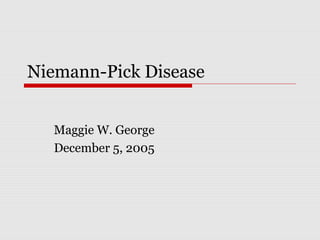
Niemann pick disease
- 1. Niemann-Pick Disease Maggie W. George December 5, 2005
- 2. The Disease Condition involving the breakdown and use of fats and cholesterol in the body Harmful amounts of lipids accumulate in the spleen, liver, lungs, bone marrow, and brain Autosomal recessive pattern of inheritance (two copies of the gene must be present) Four variants: A, B, C1, and C2 Clinical feature include: severe liver disease, breathing difficulties, developmental delay, seizures, increased muscle tone, lack of coordination, problems feeding, and inability to move eyes vertically. No treatment
- 3. Variants Types A and B: mutated SMPD1 gene SMPD gene carries instructions for cells to produce, sphingomyelinase, which processes lipids. Mutations lead to deficiency of sphingomyelinase and accumulations of cholesterol and lipids. Types C1 and C2: mutated NCP1 or NCP2 gene NCP1 gene produces a protein involved in the movement of cholesterol and lipids within a cell. May be a cholesterol pump, which is why its mutation leads to the buildup of lipids and cholesterol in the cell membrane. Plays a critical role in regulation of intracellular cholesterol trafficking NCP2 gene produces protein that binds and transports cholesterol (not fully understood).
- 4. NCP1 v. NCP2 Gene 95% of patients have mutations in the NPC1 gene Mapped at chromosome 18q11 NPC1 encodes a 1278 amino acid glycoprotein with 13 transmembrane domains. Remainder of patients have mutations in the NPC2 gene (or HE1 gene) Mapped at chromosome 14q24.3 Encodes a small soluble lysosomal protein involved in cholesterol binding. Both genes have identical biochemical patterns suggesting that the two proteins function together in cellular transport of cholesterol, glycolipids, etc. Work together to facilitate the intracellular transport of lipids from the lysosome to other cellular sites. Their precise functions and relationship remain unclear and are currently the subject of intense investigation.
- 5. NCP1 Mutations Over 130 mutations have been identified in NPC1 Results in Niemann-Pick Disease Type C1 Most found within a NPC1 specific cysteine-rich domain, suggesting that the integrity of this region is crucial for normal functioning of the protein. Mutations include: missense mutations, small deletions that generate premature stop codons, intronic mutations predicted to alter splicing, and point mutations. Specific mutation examples: exon 20 c.2932 C>T c.882-28 A>G (note that patients with this mutation had fibroblasts containing small amounts of mRNA without exon 7) point mutation in exon 20 (causing frameshift and premature stop codon) 1553G-A transition (causing a splicing error of exon 9) 2783A-C transversion that results in a gln928-to-pro amino acid substitution 3263A-G transition leading to a tyr1088-to-cys amino acid substitution 530G-A change in exon 5, resulting in a cys177-to-tyr substitution 4-bp deletion, TTAC
- 6. NCP2 Mutations Results in Niemann-Pick Disease Type C2 and frontal lobe atrophy Single amino acid changes prevents both cholesterol binding and the restoration of normal cholesterol levels in mutant cells. Specific mutation examples: 16 mutant alleles were identified representing only 5 different mutations (all had a severe impact on the protein): 1. 2 nonsense mutations, glu20 to ter (E20X): associated with severe rapid disease course • Results in a frameshift in exon 2, which generates a stop codon 4 codons downstream of frameshift • Lung involvement death from respiratory failure 1. Glu118 to ter substitution (E118X) • Result of a G-to-T transversion at nucleotide 352 in exon 1 of HE1 gene 1. 1-bp deletion (27delG) 2. Splice mutation (IVS2+5G-A): very difference clinical presentation • Milder phenotype • Childhood onset of neurologic symptoms but prolonged survival 1. Missense mutation (S67P) resulting in reduced amts of abnormal HE1 protein. *E20X was established as the most common mutant allele (56% frequency)
- 7. Lack of Knowledge Unfortunately, the NCP1 and the NCP2 gene are not fully understood, which means there is no proposed structure for either. There is a structure for the NCP2 bovine gene, but then again there is little information about the actual mutations involved.
- 8. Human to Bovine Relationship
- 11. References http://en.wikipedia.org/wiki/Niemann-Pick_disease http://www.ncbi.nlm.nih.gov/entrez/query.fcgi?cmd=Search http://www.ncbi.nlm.nih.gov/entrez/query.fcgi?db=PubMed http://www.ncbi.nlm.nih.gov/entrez/query.fcgi? db=PubMed&cmd=Retrieve&list_uids=12401890 http://www.ncbi.nlm.nih.gov/entrez/query.fcgi? db=PubMed&cmd=Retrieve&list_uids=15774455 http://www.ncbi.nlm.nih.gov/entrez/query.fcgi? db=pubmed&cmd=Retrieve&dopt=AbstractPlus&list_u ids=12974729&query_hl=1&itool=pubmed_docsum
